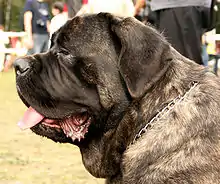Dewlap
A dewlap is a longitudinal flap of skin that hangs beneath the lower jaw or neck of many vertebrates. While the term is usually used in this specific context, it can also be used to include other structures occurring in the same body area with a similar aspect, such as those caused by a double chin or the submandibular vocal sac of a frog. In a more general manner, the term refers to any pendulous mass of skin, such as a fold of loose skin on an elderly person's neck, or the wattle of a bird. Dewlaps can be considered as a caruncle, defined as "a small, fleshy excrescence that is a normal part of an animal's anatomy".[1]

Mammals

Many mammals such as dogs, rabbits and moose possess dewlaps. In zebu cattle, the dewlap is colloquially known as the "briefcase folds". The dewlap is also found on female rabbits, such as the New Zealand white rabbit. While pregnant, the female rabbit will pluck fur from the dewlap to line a nest for her babies. Although these masses can be referred to as dewlaps, they are formed by stored fat. The dewlap is also seen in both sexes of moose.
Reptiles and birds
Many reptiles have dewlaps, most notably the anole family of lizard, which have large skin dewlaps they can extend and retract. The anole family has been found to have enhanced vision for color and depth perception.[2] This family is able to see dewlap coloration from a far distance, giving the dewlap use and importance. These dewlaps are usually of a different color from the rest of their body and, when enlarged, make the lizard seem much bigger than it really is. The dewlap is primarily used when indicating territorial boundaries and for males to attract females during the mating season. Studies have found that the pigments generating this color are pterins and carotenoids. These two pigments are the most easily seen through the anole's eyes. Pterin and carotenoid pigments are located throughout the tissue of the dewlap, creating yellow and red hues.[3] Lizards usually accompany their dewlap movement with head bobs and other displays. The dewlap moves through extension and contraction. The muscles creating this movement are known as the ceratohyoid muscles connected to the hyoid apparatus. These muscles controlling movement of the dewlap are around the throat and larynx. This is also where the motorneurons, the neurons signaling the dewlap movement, are found.[4] Though much uncertainty resides around the purpose of these displays, the color of the dewlap and the head bobs are thought to be a means of contrasting background noise.

Many birds also have dewlaps, such as domestic chickens, some cracids and some guans.
See also
References
- Lexic.us. "Definition of caruncle". Retrieved April 20, 2013.
- Sigmund, William R. (1983-01-01). "Female Preference for Anolis carolinensis Males as a Function of Dewlap Color and Background Coloration". Journal of Herpetology. 17 (2): 137–143. doi:10.2307/1563454. JSTOR 1563454.
- Steffen, John E.; McGraw, Kevin J. (2007-01-01). "Contributions of pterin and carotenoid pigments to dewlap coloration in two anole species". Comparative Biochemistry and Physiology Part B: Biochemistry and Molecular Biology. 146 (1): 42–46. doi:10.1016/j.cbpb.2006.08.017. PMID 17056290.
- Font, Enrique (1991-11-26). "Localization of brainstem motoneurons involved in dewlap extension in the lizard, Anolis equestris". Behavioural Brain Research. 45 (2): 171–176. doi:10.1016/S0166-4328(05)80082-8. PMID 1789924. S2CID 4031506.